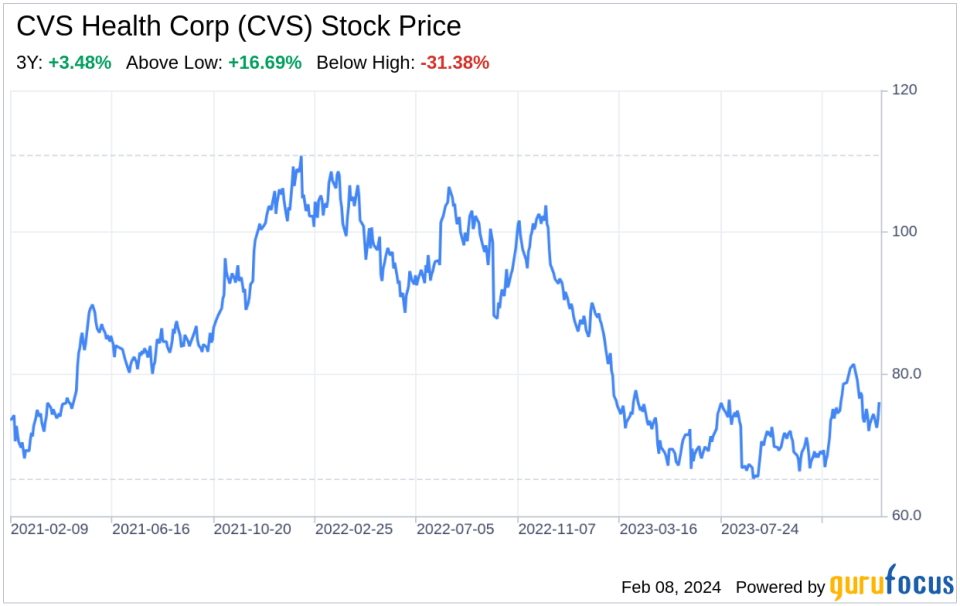Decoding CVS Health Corp (CVS): A Strategic SWOT Insight
Comprehensive SWOT analysis based on CVS Health Corp's latest 10-K filing.
Deep dive into CVS Health Corp's competitive positioning and market dynamics.
Strategic evaluation of CVS Health Corp's recent acquisitions and their impact.
Forward-looking insights into CVS Health Corp's growth and risk mitigation strategies.
On February 7, 2024, CVS Health Corp (NYSE:CVS) filed its annual 10-K report, revealing a multifaceted healthcare giant with a strong presence in retail pharmacy, pharmacy benefit management, health insurance, and primary care services. With over 9,000 retail locations, a leading pharmacy benefits manager serving approximately 108 million plan members, and a health insurer catering to around 35 million individuals, CVS Health Corp stands as a colossus in the healthcare sector. The company's strategic acquisitions of Signify Health and Oak Street Health further bolster its care delivery capabilities. Financially, CVS Health Corp's market capitalization stood at a robust $88.5 billion as of June 30, 2023, with 1.26 billion shares of common stock outstanding, underscoring its financial clout and investor confidence.

Strengths
Integrated Healthcare Model: CVS Health Corp's integrated healthcare model is a formidable strength, setting it apart from competitors. The company's ability to offer a comprehensive suite of services, from retail pharmacies to health insurance plans, creates a seamless healthcare experience for consumers. This integration allows CVS Health Corp to leverage cross-selling opportunities and synergies, leading to increased access to care, improved health outcomes, and reduced healthcare costs. The acquisitions of Signify Health and Oak Street Health further enhance this integrated model by expanding the company's primary care and home-based care capabilities, positioning CVS Health Corp as a leader in value-based care.
Market Leadership and Scale: With a commanding market share of 26.7% in U.S. retail pharmacy prescriptions and a network of over 9,000 retail locations, CVS Health Corp's scale and market leadership are unrivaled. This extensive footprint provides significant bargaining power with suppliers and payers, enabling the company to negotiate favorable terms. Additionally, the scale of operations facilitates economies of scale, resulting in cost efficiencies that can be passed on to consumers and contribute to the company's profitability.
Weaknesses
Competitive Pressures: Despite its size and market presence, CVS Health Corp faces intense competition from a variety of players, including other large pharmacy chains, supermarkets, discount retailers, and online platforms. Competitors like Walgreens, Rite Aid, and Amazon pose a constant threat to CVS Health Corp's market share, requiring continuous innovation and investment in customer service, product offerings, and pricing strategies to maintain its competitive edge.
Regulatory and Legal Risks: CVS Health Corp operates in a highly regulated industry, subject to changes in healthcare laws, policies, and regulations. Compliance with these regulations is complex and costly, and any failure to comply could result in significant fines, penalties, and reputational damage. Additionally, the company is routinely involved in litigation and other legal proceedings, which could lead to substantial financial liabilities and distract management from core business activities.
Opportunities
Expansion into Value-Based Care: The acquisitions of Signify Health and Oak Street Health present CVS Health Corp with significant opportunities to expand into value-based care, a growing segment of the healthcare industry focused on improving patient outcomes while controlling costs. These acquisitions enable CVS Health Corp to offer more comprehensive care management services and capitalize on the shift towards value-based payment models, which are increasingly favored by payers and policymakers.
Technological Advancements: CVS Health Corp has the opportunity to leverage technology to enhance its service offerings and customer experience. By investing in digital health solutions, telemedicine, and data analytics, the company can improve care delivery, personalize healthcare services, and optimize operational efficiency. Embracing technological innovation will be crucial for CVS Health Corp to meet the evolving needs of consumers and stay ahead of the competition.
Threats
Economic Uncertainties: Economic downturns and fluctuations can adversely affect consumer spending and demand for healthcare services. CVS Health Corp's diverse business segments, while providing some level of insulation, are not immune to the impacts of a weak economy. Reduced consumer spending could lead to lower sales in retail pharmacies and decreased enrollment in health insurance plans, potentially affecting the company's financial performance.
Healthcare Policy Changes: The healthcare industry is subject to potential changes in public policy and legislation, which can have far-reaching effects on CVS Health Corp's operations. Reforms to the U.S. healthcare system, such as modifications to the Affordable Care Act or changes to Medicare and Medicaid, could alter the competitive landscape, reimbursement rates, and the regulatory environment, posing significant risks to the company's business model and profitability.
In conclusion, CVS Health Corp's integrated healthcare model, market leadership, and recent strategic acquisitions position it well for continued success. However, the company must navigate competitive pressures, regulatory challenges, and economic uncertainties while capitalizing on opportunities in value-based care and technological innovation. By leveraging its strengths and addressing its weaknesses, CVS Health Corp can exploit market opportunities and mitigate potential threats, ensuring its long-term growth and sustainability in the dynamic healthcare industry.
This article, generated by GuruFocus, is designed to provide general insights and is not tailored financial advice. Our commentary is rooted in historical data and analyst projections, utilizing an impartial methodology, and is not intended to serve as specific investment guidance. It does not formulate a recommendation to purchase or divest any stock and does not consider individual investment objectives or financial circumstances. Our objective is to deliver long-term, fundamental data-driven analysis. Be aware that our analysis might not incorporate the most recent, price-sensitive company announcements or qualitative information. GuruFocus holds no position in the stocks mentioned herein.
This article first appeared on GuruFocus.
